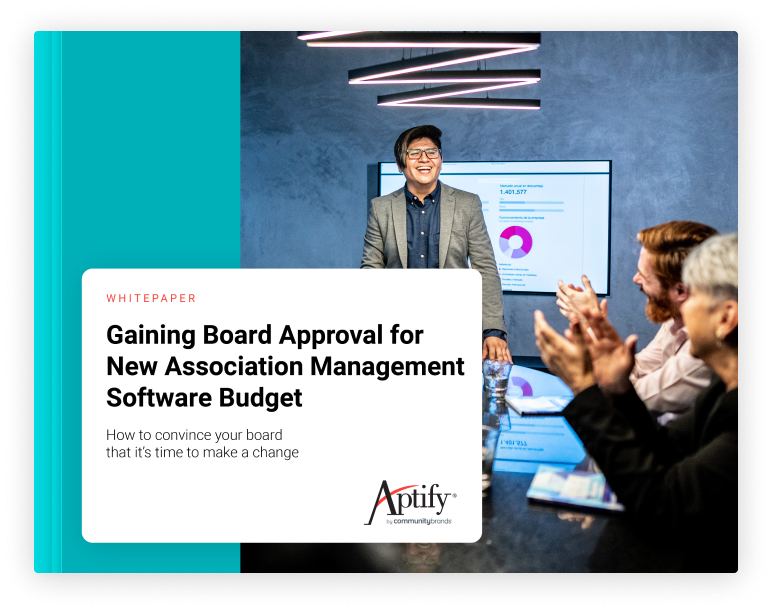Before you can get the new membership management software your organization needs, you must present to your board and convince them to make the investment. Here are six tips for getting your board on board with a new software purchase.
Ask membership professionals about their biggest challenges, and you’ll find that selecting and implementing membership software is right up there near the top of the list. Why is it so challenging?
For starters, before you even get to the selection phase, you must present to the board and convince them to fund the project. A lot is riding on acceptance of your proposal to the board: staff productivity and effectiveness, data optimization and security, and even your stress level.
But making the case to your board that it’s time for new membership management software requires research and preparation.
How do you give a good board presentation?
Here are six tips for presenting an effective business case for new membership software to your board:
1. Get your executive director on board.
Before you attempt to convince the board that your organization needs new membership management software, it’s helpful to first convince your executive director (ED). (If you’re the ED, then great! You’re ahead of the game.)
Your ED has influence with the board and can lay the groundwork for your argument and warm them up to your message. But the ED needs key points to make the case – the same facts you’ll present later to the board.
As the board meeting agenda is being developed, some board members may ask the ED for an opinion on the investment. And if the executive director isn’t on your side, it’s doubtful the board will back you up.
On the flip side, having your executive director on your side can help you anticipate objections and questions, and even determine how best to make your boardroom presentation.
2. Prepare to make a compelling presentation.
The more prepared you are to make a case for new membership management software, the more likely you’ll get what you need. Some helpful ideas on how to tell a good story that sets the stage for board approval:
Consider the language you use. Speak plainly and skip any technical jargon. Translate technical terms to plain language. Also, make the connection between the software and member value (or association goals) as often as possible.
Respect the board’s limited time. Keep your presentation concise and high-level, focusing on the new software’s impact on members, staff, and the organization. Back up these key points with details in a report you provide in advance. Give them just enough details to paint an accurate picture of your challenges today and a vision of what your organization could do in the future with new membership management software.
Do your research. Present your argument and recommendations with confidence. Be ready for questions. Prepare to overcome objections.
Listen to objections. Don’t take them lightly. If put off by how you treat a concern, a single board member can shift the mood in the room from warm to cool.
Bring project partners. For example, ask colleagues from IT, accounting, and stakeholders from other departments who are super-users of member data to join you. If called upon, they can back up your arguments. More importantly, their presence reinforces the idea that this is software that will help your entire organization.
Connect technology to member value. This is a point worth repeating. You must connect this investment to your organization’s strategic goals and the delivery of member value. If you need help making this connection, ask a few vendors for help. For example, the Aptify team has helped clients successfully make these same arguments in front of their boards.
3. Assess the current state of your membership software.
Boards are temporary guardians of your association’s money and resources. They don’t want anything to go wrong on their watch if they can help it. Because of this “safety-first” mindset, many boards are risk averse.
So, show them that sticking with your old software is riskier than investing in new technology. That might seem obvious to you, but it might not be obvious to your board.
Identify your existing membership software’s shortcomings. Start by interviewing users and stakeholders across your organization. Make sure you talk with staff from IT, accounting, membership, and other departments who use your current system and/or its data.
Some questions to ask include:
- How does the existing system keep you and your colleagues from achieving departmental goals and the organization’s strategic goals?
- What regularly causes frustration when using the system?
- What do you and your colleagues wish the system could do but doesn’t?
- What actions do you need to take, but can’t, because of the system’s limitations?
- What questions does your department have about members, prospects, and customers that can’t be answered due to the system’s limitations?
- What processes would you like to automate or streamline?
- How could technology free up your time so that you can spend more time on more strategic or useful work?
Document how your old software is impacting efficiency and effectiveness across the organization. Then, add to your list all of the ways the software prevents your organization from pursuing new strategies and tactics and how those missed opportunities impact your organization’s ability to achieve strategic and business goals. Some of these challenges may include:
- Lack of specific functionality needed to serve members, make decisions, or run business processes
- Integration difficulties and their impact on data-sharing and staff collaboration
- Reporting issues and their effect on your staff’s analytics and decision-making ability
- Inefficiencies from staff workarounds and manual processes
- Data integrity issues and their effect on staff’s confidence in data and on member service
And, while board members don’t like taking risks, sticking with older software often comes with its own risks – namely, security risks. Educate your board about protecting your member data and how an investment in updating your software is necessary. Consult your IT team and vendors to find out how your current system may not be the safest choice.
4. Paint a picture of how new membership software will help.
It’s important to show your board that new membership management software is in everyone’s best interest. Make sure board members see how new membership software can help staff make progress toward your organization’s strategic goals and departmental goals.
For example, in a trade association, the organization might be highly focused on goals around advocacy. In this case, be prepared to tell the board how new membership software will specifically help advocacy efforts.
Also, board members often love numbers. If you plan to talk about freeing up staff time by streamlining or automating processes, do your homework. Prepare evidence to show whose time, how much, and what could they do instead.
Contrast the risks and opportunity costs of staying on your existing system with the new opportunities and benefits your association will see due to increased functionality. For example:
- Data integrity, plus a 360-degree view of members, prospects, and customers
- Member self-service and its impact on data integrity and staff time
- Integration with other association systems and social media platforms
- Engagement scoring and how that can positively impact decisions, strategies, and tactics
- Reporting and analytics potential
- Mobile accessibility
- Ability to offer new types of memberships
- Software support and roadmap
Remind the board that your organization operates in a competitive environment. Modern technology can provide the competitive advantage you need to fully optimize your data and better understand members, prospects, and customers. A new membership system will give you the tools you need to improve how you communicate with, market to, and deliver value to your members.
5. Share recommended next steps.
During your initial board presentation, the board might only have time to hear your presentation and then make a decision later. But they might be ready to hear more about the project. So, be ready with an outline of an initial project plan.
Having an initial project plan will instill their confidence in you or the person or team driving the project. The board will take comfort in knowing the investment will be managed well. Be ready to give them a high-level overview of an implementation project that includes:
- Staff involvement
- Requirements gathering from across all departments
- Data cleansing
- Request for proposals
- Demos
- Selection
- Discovery process with the vendor
- Software configuration
- Data migration
- Testing
- Change management
If you anticipate that your budget request will include funds for hiring project management, business analysis, selection, and/or implementation consultants, this is a good time to discuss the benefits of going with professional expertise rather than relying on in-house staff to take on this work.
6. Be ready for budget questions.
Until you identify your requirements for new membership software and talk to vendors about configuration, integration, and data migration needs, you won’t be able to get a reliable estimate to show the board. So, avoid talking about software costs with your board until you’ve identified your requirements and received proposals from vendors. Make sure these proposals are based on your requirements and the extent of data conversion required.
In the meantime, you can discuss what goes into the price of new membership software and why you can’t provide an estimate until you know exactly what you’re going to get from each vendor.
- Factors affecting the cost include:
- Functionality required
- Integrations required
- Data conversion
- Licensing model
- Implementation
- Training
- Consultant services
Learn more about how to create a board presentation to gain approval for membership technology
As a membership organization, your association must have the right technology to support organizational goals, address challenges, and ultimately provide a member experience that attracts members and keeps them around long term. Your board’s decision to invest will depend highly on your ability to prove that new membership management software will help your organization work more efficiently and deliver better member value.
Learn more about how to convince your board it’s time to make a software change. Read the guide, Gaining Board Approval for New Association Management Software Budget.



